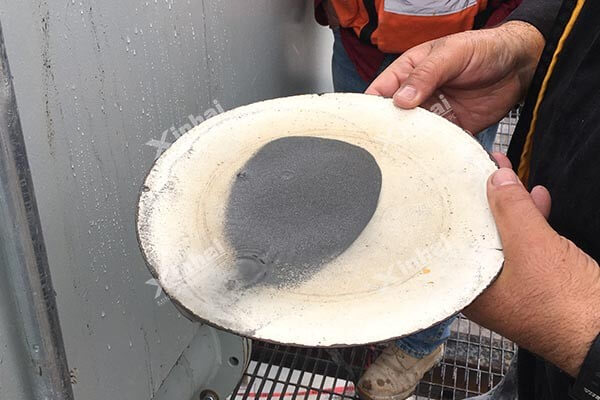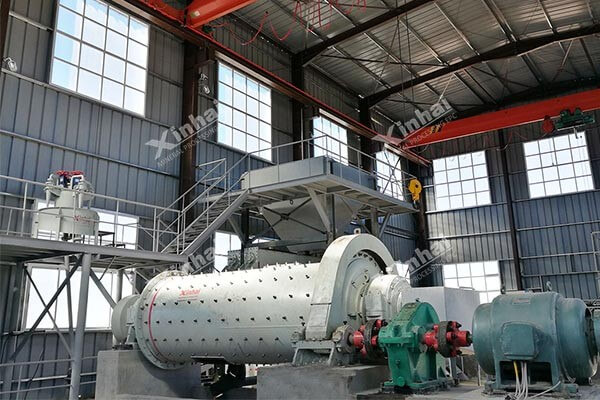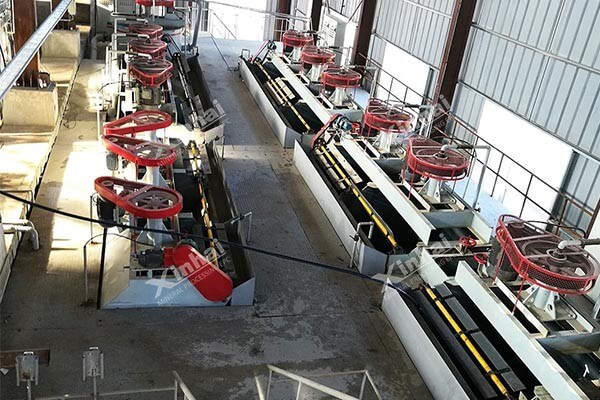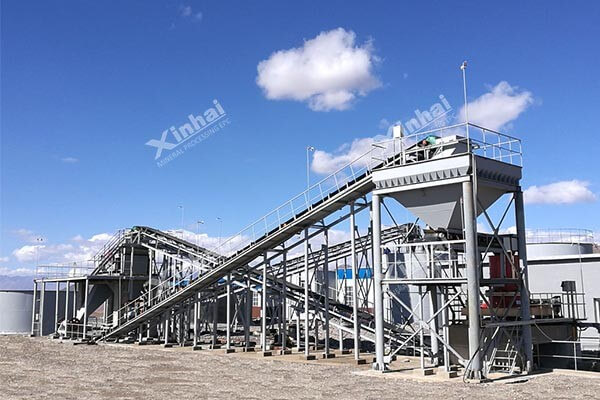

Common Silver Extraction Methods
2019-06-18 15:24:19xinhai
The required silver extraction process varies from the different mineral nature. The mineral extraction method usually used for independent silver ore centering on silver production is flotation extraction process. While paragenetic and associated silver mines often uses ingle flotation method, flotation-gravity separation method, and flotation-cyanidation method, with flotation being the most important process.
Minerals rich in silver are called silver minerals. Pure silver is silvery white, so it is also called white silver. Among all metals, silver has a series of merits including highest conductivity and the rmal conductivity, good ductility and plasticity, ease of polishing and molding, and forming alloy or psudoalloy with many metals. With the mining of silver ore, the grade of silver-bearing ore is gradually reduced. Therefore, it is very important to realize the high-efficiency extraction process of silver-bearing ore. It is of great significance to realize the comprehensive recycling of resources and promote the cyclic development of industrial economy.
Silver-bearing ore is mainly divided into gold-silver ore and lead-zinc-copper associated silver ore. Its silver production accounts for more than 99% of the total silver output.
Gold-silver Ore
In addition to gold, each ton of gold-silver ore contains tens of grams to several hundred grams of silver.
In the primary gold-silver mine, silver is often present in the form of spiral-like sulfur-silver ore, deep red-silver ore, brittle silver ore, native silver, sulphur-bismuth-copper-silver ore; In the oxidized ore, halogenide (horn silver ore) and sulphate (argentojarosite)containing silver and native silver often closely associated with clay minerals, iron oxides and manganese oxide.
Native silver particles are often covered by some metal oxide and hydroxide thin films. Gold minerals exist in the form of native gold and silver-gold ore, and the gold particles are very fine.
Lead-zinc-copper Associated Silver Ore
Silver mainly exists as independent minerals.
Various compounds of silver and sulfur, copper, lead, tin, antimony, bismuth, selenium, arsenic and other elements appear in various deposits. Commonly, there are argentite-acanthite, jalpaite, pyrargyrite, stephanite, proustite, polybasite, andorite, diaphorite, hessite and naumannite.
A small amount of silver occurs in ores as the single substance mineral, such as native silver.
There is also a small amount of silver that does not have an independent form in the ore, but forms is omorphism in the crystal lattice of other minerals, such as electrum and freibergite.
Various silver minerals are closely symbiotic with the sulfide minerals of lead, zinc and copper, and are mostly distributed as fine grain dissemination. The particle size of silver minerals is almost below 0.04 mm, the majority of silver minerals have a particle size of 0.04-0.02 mm, and the finest is only 0.001 mm.Fine silver minerals are distributed in galena, sphalerite, and copper sulfide minerals in the form of continuum, inclusions, and microscopic bodies.
During the flotation process, those sulfide minerals that are closely related to silver minerals will become their carriers, enriching silver into various concentrate products. Therefore, the occurrence and embedded properties of silver minerals have a major impact on the comprehensive extraction of silver.

Because gold-silver ores contain many kinds of silver minerals that often appear in various states, two or more mineral extraction methods are used to form a combined process for gold-silver ores extraction. In general, the extraction methods of gold-silver ore mainly include flotation and cyanidation processes. The use of flotation or cyanidation primarily depends on the composition of silver mineral:
When silver minerals are mainly pyroxene silverand natural silver, both flotation and cyanidation extraction processes can be used:
When the silver ore contains a lot of minerals hard for cyanidation such as deep-red silver minerals, light-red silver minerals,selenium silver minerals, only flotation extraction method can be used.
It is worth noting that flotation method and cyanidation method are different in terms of silver’s recovery rate. There covery rate of cyanidation method is generally higher than that of flotation method.
The common gold-silver ore extraction process has the following types:
1. Flotation + Flotation concentrate cyanidation
The sulfide ore containing gold, silver and quartz veins is subjected to flotation process to obtain a small amount of concentrate, which is then sent to cyanidation process. Compared with all-sliming cyanidation process, the flotation concentrate cyanidation process has the advantages of not requiring fine grinding minerals, reducing power consumption, occupying small plant area, and saving capital investment.
2. Flotation + Concentrate calcination + Calcination cyanidation
This process is commonly used to process in soluble gold-arsenic ore, gold-bismuth ore andgold-pyrite ore with extremely high sulfide content. The purpose of calcination is to remove elements such as arsenic and antimony which are harmful to cyanidation process.
3. Flotation + Flotation concentrate pyrometal lurgical process
Most polymetallic sulfide ores containing gold and silver are processed in this extraction process. In flotation process, gold and silver enter copper, lead and gold minerals which are closely symbiotic to them, and are sent to smelting plant to recover gold and silver.
4. Flotation + Flotation tailings or middling cyanidation+ Flotation concentrate in situ calcination cyanidation
This scheme is used to process quartz-sulfide ore containing antimony telluride, pyrrhotite, chalcopyrite and other sulfide minerals. Sulfide ore will be obtained as concentrate after flotation and the gold-silver concentrate will be conducted calcination and then cyanidation process. Due to the high content of gold and silver in flotation middlings and tailings, it is necessary to recycle by cyanidation.
5. Raw ore cyanidation + Cyanidation tailings flotation
When the gold and silver symbiotic with the sulfide in the ore cannot be completely recovered by the cyanidation method, it’s recommendable to improve the gold and silver recovery rate of the cyanidation slags after flotation process.
Silver ore characteristics and extraction methods:
Silver Ore Characteristics | Extraction Methods |
Coarse particles (> 0.1 ~ 0.2 mm) of natural silver and natural alloys | Gravity separation |
Cyanidation | |
Native silver and native alloys particles in free and intergrowth state (< 0.1 to 0.2 mm) | Cyanidation |
Flotation and cyanidation or melting of the concentrate in the next step① | |
Cerargyrite particles in free or intergrowth state | Cyanidation① |
Simple sulfide of silver in free and intergrowth state | Flotation and cyanidation or melting of the concentrate in the next step |
Cyanidation① | |
Silver telluride, selenide and complex sulfides and silver iron vanadium particles in free and intergrowth state | Oxidizing roasting or chloridizing roasting and cyanidation of calcine in the next step |
Flotation and smelting or roasting of the concentrate in the next step , and cyanidation of calcine | |
Silver in galena, chalcopyrite, chalcocite and other non-ferrous sulfide minerals | Flotation and smelting of the concentrate in the next step① |
Silver in iron sulfide | Flotation, oxidizing roasting or chloridizing roasting of the concentrate in the next step and cyanidation of calcine① |
①The coarse particles of minerals can be extracted by gravity separation.
Due to the complex mineral composition of lead-zinc-copper associated silver ore, the symbiotic relationship, embedded properties and oxidation degree of the ores are different, and the extraction effect is also very different.
At present, flotation is a common method for extracting lead-zinc-copper associated silver ore. According to the process conditions and chemical system of the main metal, it is advisable not to extract the single silver concentrate. The common extraction process is to enrich silver into lead, zinc, and copper concentrates, and then extract silver by smelting. However, in the smelting process, the silver in the lead concentrate enters the crude lead with the main metal, the silver in the copper concentrate enters the matte. Its extraction process is simple, the cost is low, and the recovery rate is high. Whether using pyrometal lurgy method or hydrometal lurgy process, the silver in the zinc concentrate will all enter the slag. The process of extracting silver by the fuming method is complicated, high in cost and low in recovery rate. Therefore, silver extraction should concentrate silver in lead and copper concentrate to the greatest extent.
In general, the recovery rate of lead-zinc-copper associated silver ore is lower than that of silver-gold ore, generally between 50-70%.
Measures to increase the recovery rate of silver in lead-zinc-copper ore:
In recent years, the rapid increase in demandfor silver and the rise in silver prices have led to wide spread attention to the comprehensive recovery of lead-zinc-copper polymetallic sulphide ore associated silver ore. In order to obtain the ideal technical and economic indicators for comprehensive recovery of mineral processing, people have strengthened the research of extraction of silver, continuously improved the beneficiation process and the reagent system, so that the ore dressing indicators of lead, zinc, copper and other sulfide ore remain at the original level or improved. The recovery rate of associated silver has been increased from 30%~50% to 60%~80%, and the production of associated silver and the level of comprehensive recovery technology have also been greatly improved.
One of the main measures to improve the associated silver recovery index is to reform the grinding process and improve the grinding fineness.
Various silver minerals are mostly fine-grained in the lead-zinc-copper poly metallic ore, which are closely symbiotic. Most of the existing grinding conditions are considered from the view point of recovering lead, zinc and copper sulfide minerals, and it is difficult to dissociate the silver minerals sufficiently. In order to improve the recovery rate of associated silver, it is necessary to reform the original grinding process and improve the fineness of grinding.
Of course, the selection of grinding process and fineness should not only consider the possibility of technology and scientificity of the process, but also consider the economic rationality.
1. Use cyanide-free or micro-cyanide process.
Silver flotation process with no or less use of cyanide, which inhibits silver minerals or carrier minerals, is beneficial to the recovery of associated silver and has received extensive attention. More than 60% of lead-zinc-copper mines have applied this method and achieved good results.
2. Increase collectors’ types and combined use of colletors
In the past, the commonly used collectors for the flotation of lead-zinc poly metallic sulfide ore in China were xanthate (ethyl, butyl) and dithiophosphate (No. 25, No. 31). In recent years, aerofloat has gradually become one of the main collectors for the flotation of lead-zinc polymetal licsulfide ore. It not only has better selectivity, but also shows a strong ability to capture silver minerals. In addition, the combined use of aerofloat with xanthate, ethyl sulfide, esters and other collectors has a good effect on the improvement of mineral processing indicators such as associated silver and lead and zinc. It has been widely used in flotation practice.
3. Improve the extraction process.
The selection of the mineral processing process should take into account the high-precision indicators of lead metal,lead and zinc, as well as the comprehensive recovery of associated silver, so that the useful minerals are recovered to the maximum extent.
For silver-containing lead-zinc polymetallic sulfide ore, if only the embedding characteristics of the associated silver are considered, the mixed flotation or partial mixing flotation process is adopted, which is beneficial to the comprehensive recovery of the associated silver. However, the selection of the flotation process is determined by various factors, and the nature of the ore is the basis. Therefore, each processing plant should repeat the production practice according to the results of the ore dressing test and gradually improve the existing process.
For silver-based ores, a combined process of gravity-flotation extraction process or a single flotation process is often used to enrich the silver minerals and then the silver concentrates are chemically extracted by chemical methods.
500tpd Silver Flotation Plant in Morocco
Ore properties:
Metallic mineral are natural silver, pyrite, limonite, etc.; gangue minerals are quartz, feldspar, clay minerals, etc. The element available for recycling is silver.
Technological Process:
Two and a half stage close - circuit crushing - two-stage grinding - flotation (one roughing, three scavenging and two concentrating) - two-stage dewatering process.

During crushing stage, Xinhai mining company used two and a half stage close-circuit crushing process. Coarse crushing and secondary crushing stage used jaw crusher, fine crushing stage used cone crusher, and screening stage used circular vibrating screen. The crushing product was transported to the original fine ore bin through belt conveyor and then sent to the proposed new plant by truck.
During grinding stage, Xinhai Mining used two-stage closed-circuit grinding process. The first grinding stage used wet grid ball mill. The discharged ore was separated by the jig using a gravity extraction process. The concentrate were finely separated by shaking table. The gravity tailings were classified by high single spiral classifier. The second grinding stage used wet overflow ball mill. The second classifying stage used hydrocyclone unit. The particle size of the ore in first grinding stage is 55% to 60% -200 mesh. The particle size of the ore in second grinding stage is 85% to 90% -200 mesh.

Flotation operation adopted one roughing, three scavenging, two concentrating process. The two-stage mechanical dehydration process was adopted in the concentrate dehydration operation. The thickener was used for first stage dehydration operation and the filter press was used for the second stage dehydration. In the end, the filter cake contained about 20% water. The tailings were directly discharged to the original tailings pond and the backwater was for cyclic utilization.
After the concentrate was transferred into the concentrate warehouse, it was then transported to the existing mixing system of the beneficiation plant. The mixing system was newly built on the basis of the original plant, which feeds with grab bucket. Through the high-concentration agitation tank for slurry mixing, the slurry was sent to the existing grinding and classifying system. After concentrated by the thickener, the hydrocyclone overflow was going to be sent to the existing leaching system for leaching over 60 hours. After five-stage washing operation, the pregnant solution was going to be delivered to the zinc powder replacement device for smelting, and the tailings were pumped to the tailings pool.

Project Advantages:
1. Rational Plant Layout, Suited to Local Conditions
● There are lots of bare rock in the plant site, and the price of concrete in Morocco is expensive. Therefore, Xinhai Mining adopted steel structure plant design, which not only saved the cost of infrastructure investment, but also shortened the period of civil construction.
● On the basis of the former cyanidation plant, Xinhai Mining appropriately added some new equipment and processes, made the most of the existing building, equipment and foundation. Through the scientific and reasonable plant design, Xinhai Mining ensured that the whole plant process flows smooth, the new and old equipment runs in order, and the expected recovery rate was achieved.
2. Advanced Process and Reliable Equipment
● Xinhai Mining adopted crusher and vibrating screen to form two and a half closed circuit crushing process, which obviously reduced the particle size of crushed ore and reduced the load of grinding mill.
● In the classifying operation, Xinhai Mining especially increased the return sand automatic lifting device, which greatly saved the power.
● In the flotation operation, Xinhai Mining configured many types of flotation machine as a flotation unit, and set a reasonable reagent regime;
● The thickener, leaching workshop, purification workshop, replacement workshop and dehydration workshop was upgraded on the original basis of the original plant. Besides, the original equipment was serviced and those damaged parts were replaced totally, which fully ensured the stable operation of the later production.
3. Low Cost, High Beneficiation Index
● With the mineral processing EPC+M+O service, the production cost of the project was reduced by 15%, which remained about 5% less than the expected cost;
● After the grinding, gravity separation and flotation, the recovery rate of silver was up to 83.95%.
Project Achievement:
At present, Morocco 500tpd silver ore flotation project has been put into operation with stable operation, reliable equipment quality, and mineral processing index and economic benefits. The project customer gave full affirmation to Xinhai mineral processing EPC+M+O service.